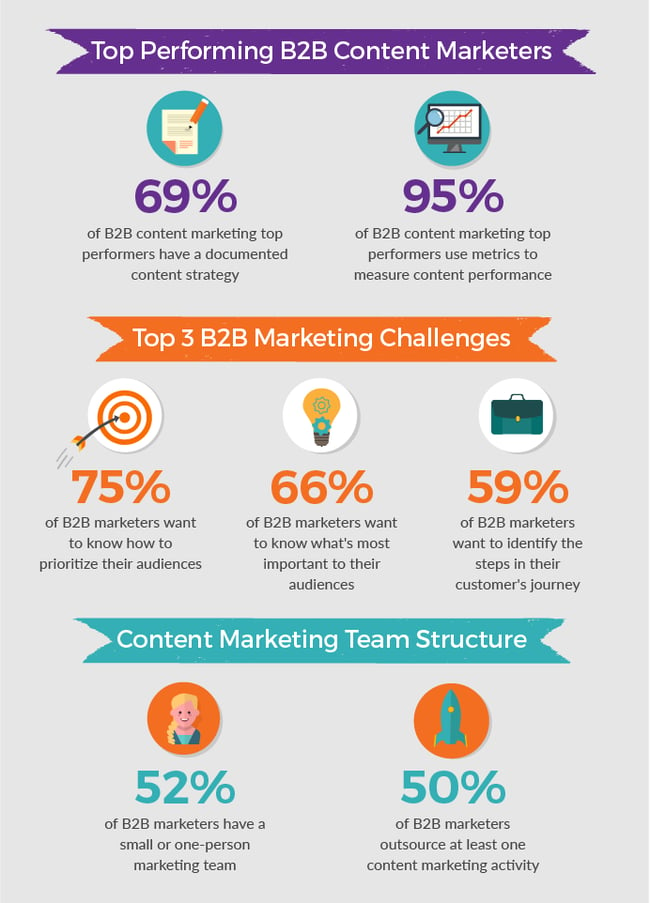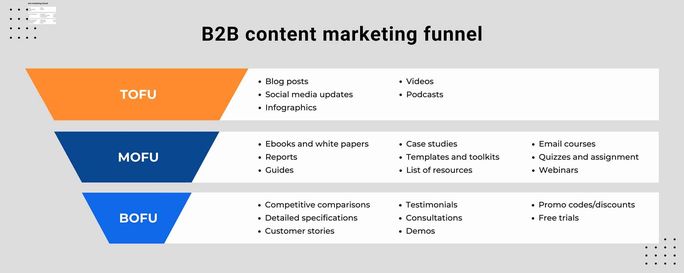Unlock the secrets to creating a successful B2B content marketing strategy from the ground up – a must-read for businesses.

Image courtesy of via DALL-E 3
Table of Contents
- Introduction to B2B Content Marketing
- Understanding Your Audience
- Setting Clear Goals
- Creating Engaging Content
- Promoting Your Content
- Building Relationships with Businesses
- Analyzing and Improving Your Strategy
- Case Studies of Successful B2B Content Marketing
- Conclusion
- Frequently Asked Questions (FAQs)
Introduction to B2B Content Marketing
When businesses want to sell their products or services to other businesses, they use a special kind of marketing called B2B content marketing. In this strategy, companies create valuable and informative content to attract other businesses. Let’s learn more about what B2B content marketing is and why it’s so important.
What is B2B?
B2B stands for Business to Business. It simply means that one business is selling its products or services to another business. For example, a company that sells software to help other businesses with their operations is engaging in B2B transactions.
What is Content Marketing?
Content marketing is when businesses create helpful content like articles, videos, or infographics to attract potential customers. Instead of pushing ads at people, content marketing pulls them in by providing useful information. This way, businesses can build trust and credibility with their audience.
Why is B2B Content Marketing Important?
B2B content marketing is essential because it helps businesses sell more effectively and also build strong relationships with other businesses. By creating high-quality content that addresses the needs and challenges of their target audience, businesses can establish themselves as experts in their industry and gain the trust of potential customers.
Understanding Your Audience
In B2B content marketing, it is crucial to understand your audience – the businesses and customers you are trying to reach. Knowing who you are creating content for helps tailor your messages and attract the right audience.
Defining Your Target Audience
To define your target audience, think about which businesses would be interested in your product or service. Consider factors such as industry, size of the company, location, and specific needs that your offering fulfills. This will help you create content that speaks directly to their interests and challenges.
Conducting Audience Research
Conducting audience research is essential to learn more about the businesses you are targeting. Simple methods like surveys, online research, and social media listening can provide valuable insights into their preferences, behaviors, and pain points. By understanding your audience better, you can create more relevant and engaging content.
Creating Audience Personas
Creating audience personas involves developing fictional representations of your ideal business customers. By giving these personas names, characteristics, and motivations, you can better understand their needs and preferences. Personas help in crafting content that resonates with your audience, leading to more effective communication and stronger connections with potential customers.
Setting Clear Goals
In the world of business, setting goals is like planning a roadmap to success. Just like having a destination in mind helps you navigate a journey, setting clear goals in your content marketing strategy helps businesses know exactly what they want to achieve. Goals give direction and purpose to your efforts, guiding you towards success.

Image courtesy of www.s2wmedia.com via Google Images
Types of Content Goals
There are different kinds of goals that businesses can set for their content marketing strategy. Some goals include increasing website visitors, generating leads, or even selling products directly. Each goal serves a specific purpose and helps businesses focus on what they aim to accomplish with their content.
How to Measure Success
Measuring success is crucial in determining if your content marketing strategy is working effectively. Tools like web analytics can help businesses track metrics such as website traffic, engagement rates, and conversion rates. By analyzing these metrics, businesses can see if they are reaching their goals and make adjustments as needed to improve their strategy.
Creating Engaging Content
Blog posts are like informative articles that provide value to other businesses. They can answer questions, offer solutions, or simply share relevant industry news. When businesses create blog posts, they showcase their expertise and build credibility in their field. By writing engaging and helpful content, businesses can attract other businesses looking for valuable information.
Videos
Videos are a fantastic way to capture attention and explain things easily to other businesses. Creating informative video content can help simplify complex ideas and make them more digestible for your audience. Whether it’s a product demo, a tutorial, or a behind-the-scenes look at your business, videos can be a powerful tool to engage and educate your business audience.
Infographics
Infographics are visual representations of information that make complex data easier to understand. Businesses can use infographics to present statistics, explain processes, or showcase comparisons in a visually appealing format. By incorporating infographics into your content strategy, you can provide valuable insights to other businesses in a format that is both educational and engaging.
Promoting Your Content
After creating valuable content for other businesses, it’s essential to ensure that it reaches your intended audience. Promoting your content effectively can help increase engagement and drive business growth. Let’s explore some key strategies to share your content with the right businesses.

Image courtesy of www.clariantcreative.com via Google Images
Using Social Media
Social media platforms like LinkedIn and Twitter are great tools to share your content with a wider audience. By posting on these platforms, you can reach more businesses who may be interested in your products or services. Make sure to use relevant hashtags and engage with your audience to maximize your reach.
Email Marketing
Email marketing allows you to directly reach businesses interested in your offerings. Sending targeted emails with valuable content can help nurture leads and drive conversions. Personalize your emails based on the recipient’s interests and needs to increase engagement and build relationships with other businesses.
SEO for B2B Content
Search Engine Optimization (SEO) practices play a crucial role in making your content easily discoverable by businesses searching for relevant solutions. By optimizing your content with relevant keywords, meta descriptions, and quality backlinks, you can improve your search engine rankings and attract more organic traffic to your website.
Building Relationships with Businesses
Networking is a key part of building relationships with other businesses. It involves connecting with people in your industry to learn from them, share ideas, and potentially collaborate on projects. One easy way to network is by using platforms like LinkedIn, where you can connect with professionals and join industry groups to expand your circle of contacts.
Creating Partnerships
Forming partnerships with other businesses can be highly beneficial for both parties involved. By combining resources, expertise, and audiences, businesses can reach new markets and achieve mutual goals. These partnerships can come in various forms, such as co-marketing initiatives, joint events, or even product collaborations.
Building Trust
Trust is a crucial element in any business relationship. It is essential to establish trust with your business partners by delivering on promises, being transparent in your communications, and consistently providing value. Producing honest and useful content can help build trust with other businesses, showing them that you are a reliable and knowledgeable partner.
Analyzing and Improving Your Strategy
When it comes to B2B content marketing, simply creating content is not enough. It’s crucial to continuously analyze how well your strategy is working and make necessary improvements. Let’s dive into why analyzing and refining your strategy is essential for success.

Image courtesy of dotit.org via Google Images
Collecting Feedback
Feedback is like a compass that guides you in the right direction. To understand what your audience wants and how they perceive your content, you can gather feedback through surveys, comments on your posts, or direct messages. This input can provide valuable insights into what is resonating with your business audience and what can be improved.
Analyzing Performance Metrics
Measuring the performance of your content is like taking a pulse of your strategy. Tools like web analytics can help you track important metrics such as page views, engagement rates, and conversion rates. By analyzing these metrics, you can see what content is performing well and what may need adjustments.
Making Adjustments
Based on the feedback and performance metrics, it’s essential to adapt and refine your content strategy. If certain types of content are not resonating with your audience, consider making changes. Whether it’s adjusting the tone of your writing, trying different formats, or targeting a new segment of businesses, being flexible and open to change is key to improving your strategy.
Case Studies of Successful B2B Content Marketing
Let’s talk about a company called XYZ Solutions, a tech start-up that skyrocketed its growth through a strategic content marketing approach. XYZ Solutions recognized the power of creating valuable content that answered their target audience’s pressing questions and pain points. They invested in producing high-quality blog posts, whitepapers, and webinars that showcased their industry expertise.
By consistently sharing these resources on their website and social media channels, XYZ Solutions attracted a loyal following of businesses seeking their services. This approach not only increased their website traffic but also generated a significant number of leads, ultimately translating into a substantial boost in sales.
Case Study 2
Another exciting success story is that of ABC Consulting, a well-established firm looking to revamp its sales strategy. ABC Consulting decided to experiment with innovative content tactics, such as personalized video messages for their clients and interactive infographics on industry trends.
These creative content formats not only captured the attention of their target audience but also positioned ABC Consulting as a forward-thinking and dynamic player in the market. As a result, their sales team found it easier to engage with prospects, leading to a noticeable increase in conversion rates and revenue.
Conclusion
In conclusion, developing a strong B2B content marketing strategy is essential for businesses looking to sell products or services to other businesses. By understanding the basics of B2B content marketing, identifying the target audience, setting clear goals, creating engaging content, promoting it effectively, building relationships with other businesses, analyzing and improving the strategy, and drawing inspiration from successful case studies, businesses can truly excel in their marketing efforts.

Image courtesy of www.socialpilot.co via Google Images
Throughout this article, we have covered the importance of knowing your audience, setting clear goals, creating engaging content like blog posts, videos, and infographics, promoting your content through various channels, building relationships with businesses, and continuously analyzing and improving your strategy. It is evident that a well-thought-out B2B content marketing strategy can drive success and growth for businesses in the digital age.
By implementing the strategies and insights discussed in this article, businesses can enhance their marketing efforts, reach their target audience more effectively, and ultimately achieve their desired objectives. Remember, consistency, creativity, relevance, and authenticity are key pillars of a successful B2B content marketing strategy.
So, don’t just settle for ordinary content marketing. Strive for brilliance in your B2B content marketing strategy and witness the remarkable impact it can have on your business. Embrace the power of content to connect, engage, and convert your business prospects into loyal customers. Here’s to creating compelling content that resonates with your audience and drives your business forward!
Want to turn these SEO insights into real results? Seorocket is an all-in-one AI SEO solution that uses the power of AI to analyze your competition and craft high-ranking content.
Seorocket offers a suite of powerful tools, including a Keyword Researcher to find the most profitable keywords, an AI Writer to generate unique and Google-friendly content, and an Automatic Publisher to schedule and publish your content directly to your website. Plus, you’ll get real-time performance tracking so you can see exactly what’s working and make adjustments as needed.
Stop just reading about SEO – take action with Seorocket and skyrocket your search rankings today. Sign up for a free trial and see the difference Seorocket can make for your website!
Frequently Asked Questions (FAQs)
What is the difference between B2B and B2C content marketing?
In B2B content marketing, businesses create and distribute content to other businesses to attract and engage them as potential customers. On the other hand, B2C content marketing focuses on reaching individual consumers directly. The key difference lies in the target audience, as B2B targets businesses, while B2C targets individual consumers.
How long does it take to see results from B2B content marketing?
The timeline for seeing results from B2B content marketing efforts can vary depending on various factors such as the type of content, the target audience, and the overall marketing strategy. Generally, it may take a few months to see significant results as businesses build relationships and trust with other businesses through consistent and valuable content.
What are some common mistakes to avoid in B2B content marketing?
Some common mistakes to avoid in B2B content marketing include:
- Ignoring the needs and preferences of the target audience
- Not setting clear goals for the content strategy
- Overlooking the importance of analytics and measurement
- Not optimizing content for search engines (SEO)
- Failure to adapt and adjust the strategy based on feedback and performance metrics







